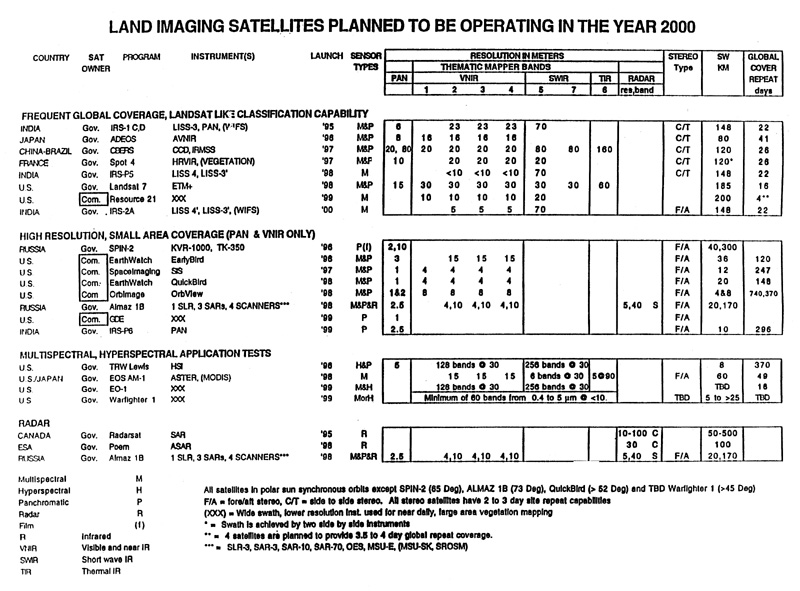



SYNTHETIC APERTURE RADAR
APPLICATIONS
Appendix 7
REVIEW OF PAST, PRESENT, AND FUTURE
EARTH OBSERVING PLATFORMS*
USGS Biological Resources Division
*Excerpted from copies of viewgraphs prepared by the USGS Biological Resources Division, Office of Biological Information and Outreach (OBIO), Earth Observation Platforms, "An Overview," 2 April 1997, 17 p.
CURRENT DATA SOURCES AND
RESOLUTION
PIXEL
SENSOR SOURCE RESOLUTION
(in meters for
satellite imagery)
Satellite, Optical: JERS-1 24
IRS-1 36
LANDSAT TM 30
LANDSAT MSS 80
SPOT PAN 10
SPOT MSS 20
Satellite, Radar: ERS-1 30
JERS-1 18
RADARSAT varies
Airborne: Air/Ortho Photo varies
Geophysical: Gravity varies
Magnetics varies
Radiometrics varies
Seismic varies
SPATIAL RESOLUTION (PIXEL)
Low greater than 30 meter
Medium 6 meter - 30 meter
High 1 meter- 5 meter
SATELLITE ORBITS
Three types of orbits for earth observing systems:
Polar Orbit - satellite tracks near the North and South poles at an altitude above the earth at 500 to 1000 km. Polar orbits provides for coverage over most of the earth's surface.
Repeat Cycle - is expressed in days and represents the time taken for the satellite to return to the same position over the earth's surface. LANDSAT 5 has a repeat cycle of 16 days.
Sun-synchronus - the satellite passes over an area at approximately the same local sun time as the satellite passes over the equator.
Period - time taken to complete one orbit around the earth. Inclination - the angle which the satellite orbit makes with the equator is defined as its inclination. A polar orbit would have an inclination of 90 degrees. Landsat 5 has an orbital inclination of 98.2 degrees. It is measured on the North and South (or descending) part of the orbit.
Coverage - represents the areas of the earth which are observed after one repeat cycle. For polar orbits this is usually given as maximum latitudes North and South.
Geostationary Orbits - the satellite possessed an orbital speed matching the rotation rate of the earth. At an altitude of 35,900 km. Coverage of the earth is limited to one specific hemisphere.




SYNTHETIC APERTURE RADAR
APPLICATIONS
SAR Provides High-Resolution Imagery, Independent of Cloud Cover, Sensitive to Survace Roughness, Structure, and Dielectric Constant.
Flooding Vegetation growth and leaf-shedding
Environmental damage to vegetation
Slash and burn agriculture
Logging
Change of surface moisture content
Change of vegetation moisture content
Rain and snow storms
Freezing and thawing changes
Erosion
Earthquakes
Surface motion (glaciers)
Land subsidence
Swelling in volcanically active regions
- Additional Revisit Cycles
- Stereo Imaging
- Programmable Sensors
- On-board Data Storage
- Improved Communications
FUTURE SENSOR AVAILABAILITY
- Spot 3-4
- IRS-P2,1B
- ERS-1,2
- Priroda-mom2
- Lewis
- Clark
- Early Bird
- CRSS
- ASTROVISION
- EXEGLASS
- SEASTAR
- ADEOS
- RADARSAT
CRITICAL ISSUES
-Coverage frequency and timeliness
-Spatial resolution
-Sensor calibration
-Atmospheric Correction